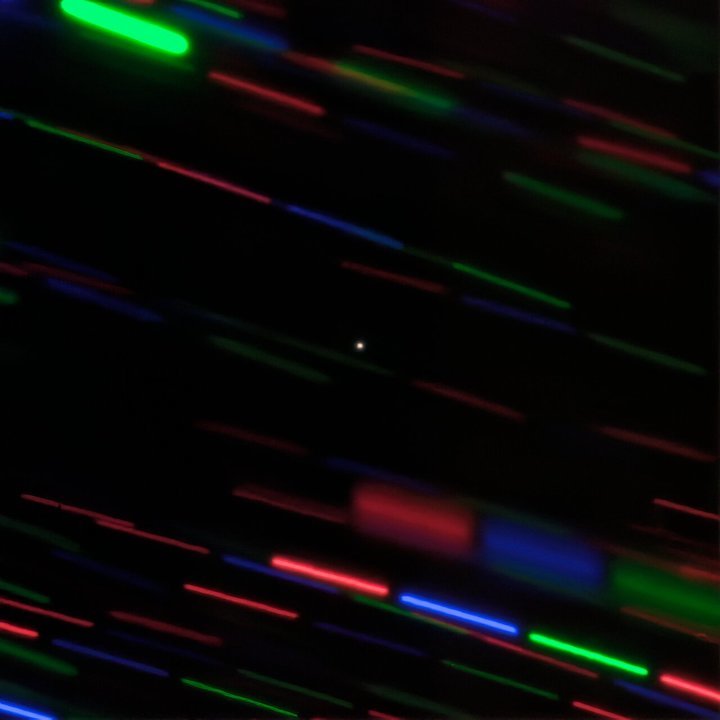27.11.2020

International Gemini Observatory image of 2020 CD3 (center, point source) obtained with the 8-meter Gemini North telescope on Hawaii’s Maunakea. The image combines three images each obtained using different filters to produce this color composite. 2020 CD3 remains stationary in the image since it was being tracked by the telescope as it appears to move relative to the background stars, which appear trailed due to the object’s motion. Credit: International Gemini Observatory/NOIRLab/NSF/AURA/G. Fedorets
Lowell Scientists Help Characterize Second Known Minimoon
Flagstaff, AZ. – Astronomers using data collected with the Lowell Discovery Telescope (LDT) have helped to characterize only the second known minimoon of Earth, a newly discovered asteroid with the designation 2020 CD3, or CD3 for short. The LDT observations helped to clarify both the rotation rate and the orbit of this diminutive body, the latter of which helped prove that CD3 is a natural body and not some relic piece of human-made space junk.
Minimoons are small asteroids temporarily captured into orbit around Earth. Within about a year, they are flung back into interplanetary space. The first known minimoon, 2006 RH120, was detected 14 years ago.
CD3 was discovered on February 15, 2020 by Kacper Wierzchos and Teddy Pruyne via the Catalina Sky Survey, operating out of the University of Arizona’s Lunar and Planetary Laboratory. Due to the rarity of minimoons, a global effort led by postdoctoral research fellow Grigori Fedorets of Queen’s University Belfast was quickly launched to study this object. Twenty-three researchers from 14 academic institutions in seven countries participated, using several telescopes including the LDT. The team made observations through mid-May 2020 and published their results today in the Astronomical Journal.
Lowell Observatory astronomer Nick Moskovitz and former Lowell postdoctoral fellow/current Arecibo Observatory scientist Maxime Devogele participated in the effort, assisted in observing on the LDT by the University of Maryland’s Quanzhi Ye. By measuring CD3’s changing brightness over time (i.e. its light curve) with the Large Monolithic Imager (LMI) on the LDT, they established its rotation rate to be about three minutes. Fedorets said, “The rotation rate was probably the largest unanswered question of this research. The Lowell team showed that it rotates slower than anticipated for objects of this size range.”
Moskovitz and his Lowell colleagues also used the LMI/LDT combination to precisely measure CD3’s position to refine its orbit. This information, combined with CD3’s physical characteristics—such as an inferred silicate composition—indicate this is certainly a natural object. This distinguishes it from another recently discovered object, 2020 SO, which scientists believe may be the upper stage of NASA’s Surveyor 2 spacecraft.
The study estimates CD3 is approximately 1-1.5 meters in diameter—about the size of a small car— and that it came within about 13,000 kilometers (8,100 miles) of Earth at closest approach. Observing objects this small is challenging and requires a telescope big enough to see them. In addition, their transient nature means the window of time to observe them can close quickly. Enter the 4.3-meter LDT, Lowell Observatory’s flagship telescope. Its large size and ready availability make it optimized for such studies. Moskovitz said, “This object wasn’t bright enough to study for very long. The fact that we have this telescope in our backyard and were able to rapidly respond really made a difference.”
The global response to CD3 may very well serve as a template for future minimoon studies, which scientists anticipate to happen soon. According to Fedorets, “Minimoons are expected to be discovered in high numbers in the following decade, with the opening of the Vera C. Rubin Observatory expected in 2023.” This facility is now being built in Chile and features an 8.4-meter telescope that will allow astronomers to detect many more small bodies such as minimoons.
Scientists are interested in learning more about these bodies for several reasons. Because minimoons are close to Earth, they are potentially accessible targets for robotic or human exploration. Such efforts will be scientifically valuable to understand the origin of these objects and their relationship to other asteroid and comet populations in the solar system. These objects could also someday be commercially important as targets for in-space resource mining.
Lowell Observatory owns and operates the LDT in partnership with Boston University, the University of Maryland, the University of Toledo, Northern Arizona University, and Yale University. Its primary imager is the LMI, featuring the largest charge coupled device (CCD) that is manufactured. The camera provides a 0.2 degree by 0.2 degree field of view, and was funded by the National Science Foundation.
Quelle: Lowell Observatory
